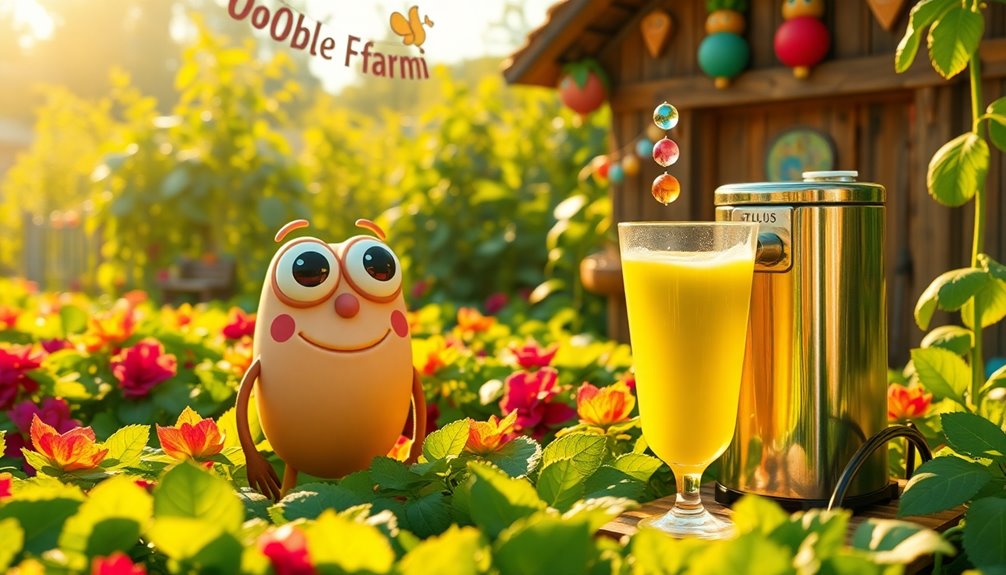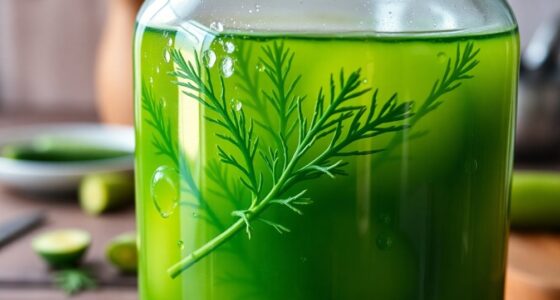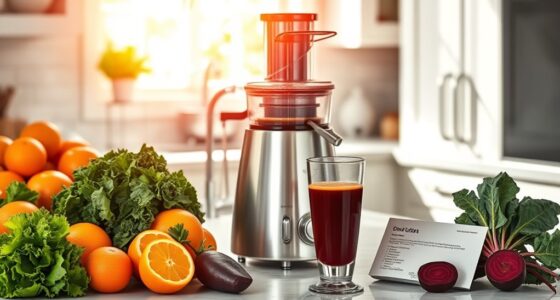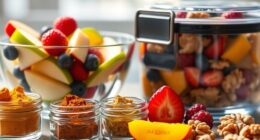To get Bean Juice in Ooblets, you can buy it at Cuddlecups Cafe for 30 gummies each. It's a quick way to boost your energy and speed. If you prefer crafting, gather Ground Springbeans and use a Kettle and Cup, which costs 1,500 gummies. First, process Springbeans in a Crunchster to create Ground Springbeans. This method might take longer but can be cost-effective. There are plenty of other tips to optimize your Bean Juice experience right here!
Key Takeaways
- Purchase Bean Juice at Cuddlecups Cafe for 30 gummies each for an immediate energy boost.
- Craft Bean Juice using a Kettle and Cup, requiring 1,500 gummies and Ground Springbeans.
- Gather Ground Springbeans by processing Springbeans in a Crunchster after harvesting.
- Plant Springbean seeds, which cost 6 gummies each, and wait five days for them to mature.
- Use Bean Juice strategically to enhance run speed and complete tasks more efficiently in Ooblets.

If you're looking to boost your energy in Ooblets, getting your hands on some Bean Juice is a great option. This consumable not only replenishes 40 energy but also increases your run speed by 15% for five minutes, making it perfect for exploring the vibrant world of Ooblets or tackling various tasks.
You've got a couple of routes to snag this energizing drink, whether you prefer the quick buy from Cuddlecups Cafe or diving into the crafting process yourself.
If you're in a hurry, head over to Cuddlecups Cafe. Here, you can purchase Bean Juice for 30 gummies each. It's a convenient option when you need an immediate boost. Just stock up your gummies, and you'll be refueled in no time.
However, if you're feeling crafty and want to dive into the farming games aspect of Ooblets, consider crafting your own Bean Juice. This option is a bit more involved but can be rewarding in the long run.
To start crafting Bean Juice, you'll first need to acquire a Kettle and Cup, which costs 1,500 gummies. This is a worthwhile investment, as it opens up more crafting possibilities beyond just Bean Juice.
Once you've got your Kettle and Cup, the next step is to gather some Ground Springbeans. To make Ground Springbeans, you'll need to process Springbeans in a Crunchster. You can obtain the recipe for Ground Springbeans from the Wishy Well for 50 Wishies, so keep that in mind as you gather resources.
If you want to grow your own Springbeans, you can buy Springbean seeds for 6 gummies each. Planting these seeds will require some patience, as it takes about five days for them to mature into harvestable plants.
Once harvested, you can turn those Springbeans into Ground Springbeans and then craft your Bean Juice. This method not only saves you gummies in the long run but also immerses you in the delightful farming aspect of the game.
Using Bean Juice strategically can be a game-changer, especially when you're out and about on your Nintendo Switch. With the extra run speed, you'll zip around quicker, making exploration and completing tasks a breeze.
Whether you opt for the instant gratification from Cuddlecups Cafe or the satisfaction of crafting your own, Bean Juice is a valuable asset for anyone navigating the whimsical world of Ooblets.
Frequently Asked Questions
How to Get Bean Juice Recipe in Ooblets?
To get the bean juice recipe, you'll need to head to the Wishy Well in Badgetown.
First, make sure you've unlocked the Ground Springbeans recipe, as both require 50 Wishies. You can earn Wishies by completing daily tasks and collecting badges.
Once you've gathered enough, exchange them at the Wishy Well for the bean juice recipe.
After that, you can craft it using Ground Springbeans in the Kettle and Cup.
Where Can I Get Spring Beans Ooblets?
Imagine a garden waiting to bloom, where each seed represents a new adventure.
To get Springbeans, head over to Meeds Seeds on the east side of Badgetown, where you can buy them for 6 gummies each. You might also find seeds by weeding or breaking wooden planks, but that's hit or miss.
Once you plant them, wait five days for them to grow, and soon you'll be ready to harvest!
How to Get All Recipes in Ooblets?
To get all recipes in Ooblets, you'll want to focus on collecting Wishies. Complete daily tasks and earn badges to gain these valuable points.
Head over to the Wishy Well, where you can spend 50 Wishies on each recipe. Remember, some recipes require crafting items, so make sure you gather the necessary ingredients and unlock the appropriate tools first.
Keep growing your resources, and you'll unlock everything in no time!
How to Make Ground Beans Ooblets?
To make Ground Springbeans in Ooblets, you'll first need to buy Springbean seeds from Meeds Seeds for 6 gummies and plant them on your farm.
After five days, harvest the Springbeans and use a Crunchster to process them. You can craft a Crunchster using the Fabricuter, which you access from the furniture shop.
Alternatively, you can buy Ground Springbeans at Cuddlecups Cafe for 16 gummies if you prefer not to craft them.
Conclusion
In the vibrant world of Ooblets, bean juice is a treasure waiting to be uncovered. By following the steps outlined, you'll find yourself sipping on this delightful brew in no time. Remember, like a seed sprouting into a bountiful plant, persistence is key. So, keep exploring, gathering, and experimenting, and soon you'll be basking in the sweet satisfaction of your hard-earned bean juice. Let your Ooblet journey flow like the juice itself—refreshing and full of surprises!
Cindy thoroughly researches juicing trends, techniques, and recipes to provide readers with practical advice and inspiration. Her writing style is accessible, engaging, and designed to make complex concepts easy to understand. Cindy’s dedication to promoting the advantages of juicing shines through her work, empowering readers to make positive changes in their lives through the simple act of juicing.











